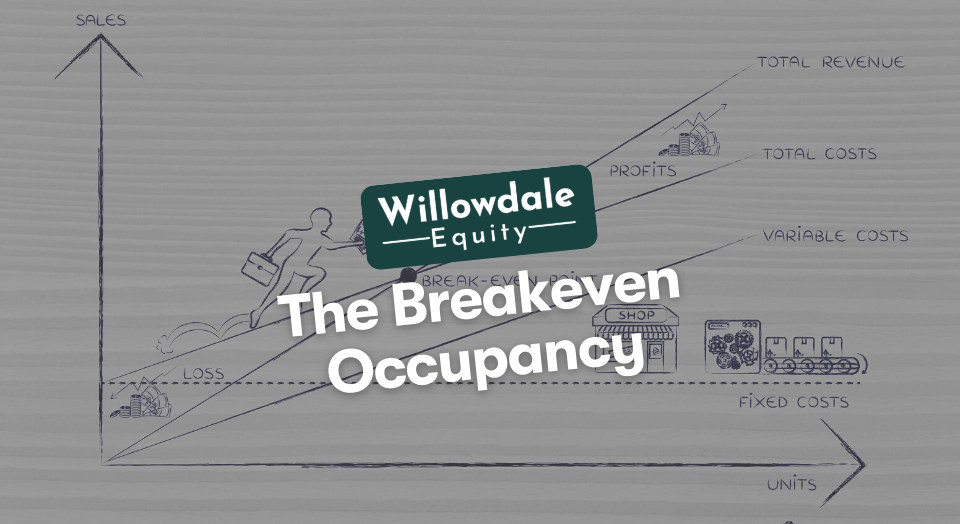
The Breakeven Occupancy in Multifamily Real Estate
This article is part of our guide on passive investing in multifamily via syndication, available here.
Understanding occupancy and cash flows are crucial to know how much exposure you can take on as a multifamily operator before you’re at a deficit. In today’s market, U.S. apartment unit occupancy is at all-time highs due to supply constraints, but each property in each market has its own pulse.
As an operator, you have to be able to foresee and calculate what the breakeven occupancy ratio is for your property on behalf of your real estate investors.
Key Takeaways
-
In commercial multifamily real estate investing, the breakeven occupancy is the occupancy number at which the real estate investment no longer cash flows and instead is losing money and in an operating deficit.
-
The breakeven occupancy in multifamily real estate is used to stress test a prospective property acquisition. An operator will run the breakeven occupancy formula to determine how much vacancy the property can sustain before it burns cash.
-
A good breakeven occupancy is anywhere from 62% to 85%.
What is Breakeven Occupancy in Multifamily Real Estate?
In commercial multifamily real estate investing, the breakeven occupancy is the occupancy number at which the real estate investment no longer cash flows and instead is losing money and in an operating deficit.
Breakeven Occupancy Formula: How to Calculate Breakeven
The breakeven occupancy is a straightforward formula to calculate; all you need is three figures to perform the calculation. The following is the formula:
Breakeven Occupancy = (Total Operating Expenses + Total Debt Service) / Potential Rental Income
Breakeven Occupancy Example in Multifamily
Let’s say we had a 200-unit apartment community with an annual gross scheduled income of $3,000,000 and $1,300,000 in annual operating expenses.
Let’s also say that you had $700,000 in annual debt service.
Now that we have these three numbers, we can run the formula as follows:
($1,300,000 + $700,000) / $3,000,000 = 0.66 Breakeven Occupancy
In the chart below, I break down an example of a five-year lookback on a property. Starting with the same numbers used in the 200-unit apartment complex example above and breaking down the variability of the breakeven occupancy year over year.
| Year 1 | Year 2 | Year 3 | Year 4 | Year 5 | |
|---|---|---|---|---|---|
| Gross Scheduled Income The projected income for that particular year. | $3,000,000 | $3,025,000 | $3,140,530 | $3,300,000 | $3,346,000 |
| Operating Expenses The ongoing expenses needed to operate the property. | $1,300,000 | $1,339,000 | $1,343,000 | $1,392,000 | $1,434,000 |
| NOI The Net Operating Income which get by subtracting the operating expenses from the gross income. | $1,700,000 | $1,686,000 | $1,797,530 | $1,908,000 | $1,912,000 |
| Debt Service The annual mortgage payment. In this example, the rate in fixed. | $700,000 | $700,000 | $700,000 | $700,000 | $700,000 |
| Free Cash Flow The net cash flow after your operating expenses and after servicing your mortgage. | $1,000,000 | $986,000 | $1,097,530 | $1,208,000 | $1,212,000 |
| Breakeven Occupancy The occupancy rate before you go into negative cash flow. | 66.6% | 67.4% | 65% | 63.3% | 63.7% |
Next, we’ll look at how the breakeven occupancy is used in multifamily real estate.
How the Breakeven Occupancy is Used in Multifamily Real Estate
The breakeven occupancy in multifamily real estate is used to stress test a prospective property acquisition. An operator will run the breakeven occupancy formula to determine how much vacancy the property can sustain before it burns cash.
This is vital for any multifamily acquisition, especially when you are acquiring a property with a value-add component. Meaning physical or operational improvements will be made to the property, which tends to cause a natural dip in occupancy throughout the stabilization period.
Now that we understand what it’s used for, let’s look at what would be considered a good breakeven occupancy or a comfortable range for multifamily properties.
What's a Good Breakeven Occupancy?
A good breakeven occupancy is anywhere from 62% to 85%. For simple math, this means that on a 100-unit apartment community, you could, on average have anywhere from 15-38 units vacant before you hit negative cash flow.
Finding a deal in this day and age with a breakeven occupancy on the lower end of that range is very difficult to find. This is of course, due to apartment values being very strong, making it much more challenging to create this kind of scenario. That being said, the more you’re able to add value to the tenant base, increase rents, lower delinquencies, and optimize expenses, the closer you’ll get to a lower breakeven occupancy.
Frequently Asked Questions About The Breakeven Occupancy Formula
To calculate the occupancy growth, you would take the present occupancy and subtract it from the previous month’s occupancy; then, you would divide that number by the previous month’s occupancy to get the occupancy growth rate.
Breakeven rent is similar to breakeven occupancy, except in breakeven rent, you’re looking to find what gross rental amount you need to calculate to break even.
Breakeven Occupancy in Multifamily - Conclusion
The breakeven occupancy rate is a relatively simple calculation to ensure a real estate investor understands how much runway the property has until it needs cash.
This provides a great piece of mind in any economic phase, especially in uncertain phases of the economic cycle. If you’re interested in getting access to private value-add multifamily investment opportunities across the southeastern united states, join the investors club here at Willowdale Equity.
Interested In Learning More About PASSIVE Real Estate Investing In Multifamily Properties?
Get Access to the FREE 5 Day PASSIVE Real Estate Investing Crash Course.
In this video crash course, you’ll learn everything you need to know from A to Z
about passive investing in multifamily real estate.
We’ll cover topics like earned income vs passive income, the tax advantages, why multifamily, inflation, how syndications work, and much much more!




